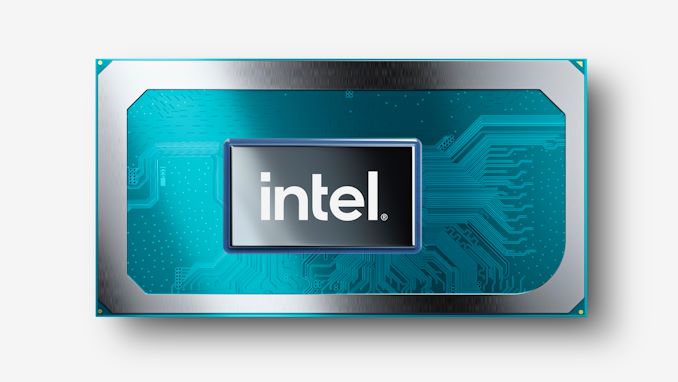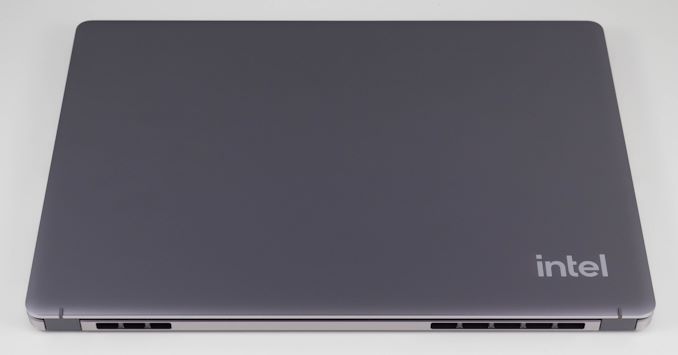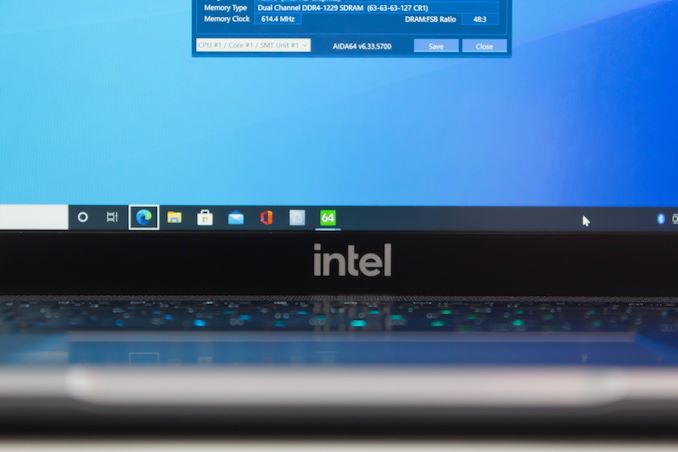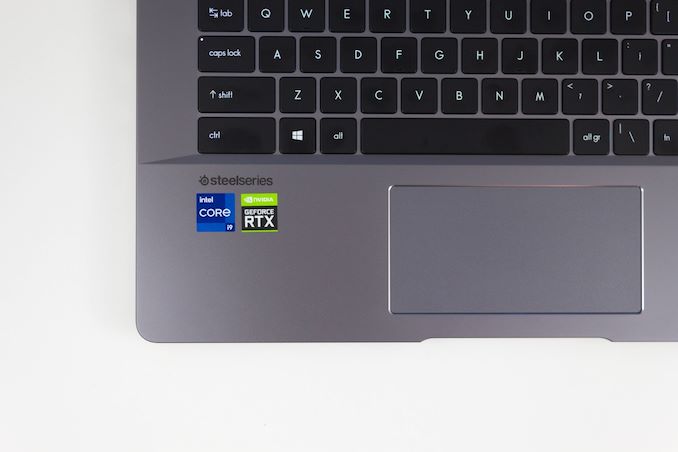Intel 11th Generation Core Tiger Lake-H Performance Review: Fast and Power Hungry
by Brett Howse & Andrei Frumusanu on May 17, 2021 9:00 AM EST- Posted in
- CPUs
- Intel
- 10nm
- Willow Cove
- SuperFin
- 11th Gen
- Tiger Lake-H

Last week Intel launched their Tiger Lake-H family of laptop processors. Aimed at the larger 14-inch and above laptops, this processor family is Intel’s newest offering for the high-performance laptop market, stepping in above Intel’s mobility-focused U and Y series of chips. Based on the same Tiger Lake architecture that we first became familiar with last year, Tiger Lake-H is bigger and better (at least where the CPU is concerned), offering up to 8 CPU cores and other benefits like additional PCIe lanes. Overall, Intel’s H-series chips have long served as the performance backbone of their laptop efforts, and with Tiger Lake-H they are looking to continue that tradition.
While last week was Tiger Lake-H’s official launch, as has become increasingly common for laptop launches, the embargoes for the launch information and for hardware reviews have landed on separate dates. So, while we were able to take about the platform last week, it’s only today that we’re able to share with you our data on TGL-H – and our evaluation on whether it lives up to Intel’s claims as well as how it stacks up to the competition.
Like Intel’s other laptop chips, Tiger Lake-H has multiple facets, with the company needing to balance CPU performance, GPU performance, and power consumption, all while ensuring it’s suitable to manufacture on Intel’s revised 10nm “SuperFin” process. Balancing all of these elements is a challenge in and of itself, never mind the fact that arch-rival AMD is looking to compete with their own Zen 3 architecture-based Ryzen 5000 Mobile (Cezanne) APUs.
| Intel Tiger Lake-H Consumer | ||||||||||
| AnandTech | Cores Threads |
35W Base |
45W Base |
65W Base |
2C Turbo |
4C Turbo |
nT Turbo |
L3 Cache |
Xe GPU |
Xe MHz |
| i9-11980HK | 8C/16T | - | 2.6 | 3.3 | 5.0* | 4.9 | 4.5 | 24 MB | 32 | 1450 |
| i9-11900H | 8C/16T | 2.1 | 2.5 | - | 4.9* | 4.8 | 4.4 | 24 MB | 32 | 1450 |
| i7-11800H | 8C/16T | 1.9 | 2.3 | - | 4.6 | 4.5 | 4.2 | 24 MB | 32 | 1450 |
| i5-11400H | 6C/12T | 2.2 | 2.7 | - | 4.5 | 4.3 | 4.1 | 12 MB | 16 | 1450 |
| i5-11260H | 6C/12T | 2.1 | 2.6 | - | 4.4 | 4.2 | 4.0 | 12 MB | 16 | 1400 |
| *Turbo Boost Max 3.0 | ||||||||||
Intel’s Reference Design Laptop: Core i9-11980HK Inside
For our Tiger Lake-H performance review, Intel has once again sent over one of their reference design laptops. As with the Tiger Lake-U launch last year, these reference design laptops are not retail laptops in and of themselves, but more of an advanced engineering sample designed to demonstrate the performance of the underlying hardware. In this specific case, the BIOS identifies that the laptop was assembled by MSI.
Wanting to put their best foot forward in terms of laptop performance, Intel’s TGL-H reference design laptop is, as you’d imagine, a rather high-end system. The 16-inch laptop is based around Intel’s best TGL-H part, the Core i9-11980HK, which offers 8 Willow Cove architecture CPU cores with SMT, for a total of 16 threads. This processor can turbo as high as 5.0GHz on its favored cores, a bit behind Intel’s previous-generation Comet Lake-H CPUs, but keeping clockspeeds close while making up the difference on IPC.
Unfortunately, their desire to put their best foot forward means that Intel has configured the CPU in this system to run at 65W, rather than the more typical 45W TDP of most high-end laptops. 65W is a valid mode for this chip, so strictly speaking Intel isn’t juicing the chip, but the bulk of the Tiger Lake-H lineup is intended to run at a more lap-friendly 45W. This gives the Intel system an innate advantage in terms of performance, since it has more TDP headroom to play with.
| Intel Reference Design: Tiger Lake-H | |
| CPU | Intel Core i9-11980HK 8 Cores, 16 Threads 2600 MHz Base (45W) 3300 MHz Base (65W) 5000 MHz Turbo 2C 4500 MHz Turbo nT |
| GPU | Integrated: Xe-LP Graphics 32 Execution Units, up to 1450 MHz Discrete: NVIDIA GeForce RTX 3060 Laptop 30 SMs, up to 1703MHz |
| DRAM | 32 GB DDR4-3200 CL22 |
| Storage | 2x OEM Phison E16 512GB SSD (NVMe PCIe 4.0 x4) |
| Display | 16-inch 2560x1600 |
| IO | 2x USB-C 2x USB-A |
| Wi-Fi | Intel AX210 Wi-Fi 6E + BT5.2 Adapter |
| Power Mode | 65 W (Mostly tested at 45W) |
Meanwhile the focus on CPU performance with TGL-H does come at a cost to integrated GPU performance. TGL-H parts include Intel’s Xe-LP GPU, but with only 32 EUs instead of the 96 found on high-end Tiger Lake-U systems. With TGL-H, Intel is expecting these systems to be bundled with discrete GPUs, so they don’t dedicate nearly as much die space to an integrated GPU that may not get used much anyhow. To that end, the reference system comes with an NVIDIA GeForce RTX 3060 Laptop graphics adapter as well, which is paired with its own 6GB of GDDR6.
Rounding out the package, the system comes with 32GB of DDR4-3200 installed. Storage is provided by a pair of Phison E16-based OEM drives, allowing Intel to show off the benefits of PCIe 4.0 connectivity for SSDs. Finally, Wi-Fi connectivity is also Intel-powered, using the company’s new AX210 adapter, which offers Wi-Fi 6E + BT5.2 on a single M.2 adapter. It’s worth noting that the AX210 is a fully discrete adapter, so it doesn’t leverage TGL-H’s integrated (CNVi) MAC, as that doesn’t support Wi-Fi 6E.
And, in keeping with making this reference system look as close to a retail design as reasonably possible, Intel even put the usual Intel Core and NVIDIA GeForce stickers on the laptop.
Unfortunately, we’ve had relatively little time with the system ahead of today’s embargo. The embargo on performance figures was originally scheduled for last Thursday (May 13th). However due to delays in shipping these laptops to reviewers, we didn’t receive the system until the end of last week, and Intel bumped back the embargo accordingly. So with just over two days to look over the system, we’ve really only had a chance to take a look at the most critical aspects of the system when it comes to performance.














229 Comments
View All Comments
ozzuneoj86 - Monday, May 17, 2021 - link
While it is nice that it supports gen 4, realistically you're just getting SSDs that put out more heat, with more power draw, while gaining performance benefits that are only measurable in benchmarks or very specific situations.I'm sure file copy performance is much higher, but how fast do you need that to be? Assuming you're copying to the drive itself or maybe to a Thunderbolt 4 external drive, it is the difference between copying 1TB of data in 2 minutes versus 6 minutes. You can (theoretically) completely fill a $400 2TB SSD in 4 minutes with gen4 vs maybe 12 minutes with Gen 3. If someone needs to do that all the time, then sure there's a difference... but that has to be pretty uncommon.
For smaller amounts of data, any decent nvme drive is fast enough to make the difference between models almost unnoticeable. For the vast majority of users, even a SATA drive is plenty fast enough to provide a smooth and nearly wait-free experience.
mode_13h - Monday, May 17, 2021 - link
> realistically you're just getting SSDs that put out more heat, with more power draw,> while gaining performance benefits that are only measurable in benchmarks
> or very specific situations.
Exactly. Thank you.
mode_13h - Monday, May 17, 2021 - link
> Assuming you're copying to the drive itself or maybe to a Thunderbolt 4 external driveOops! TB 4 is limited to PCIe 3.0 x4 speeds! So, it'd be little-to-no help there!
Calin - Tuesday, May 18, 2021 - link
Well, you could copy full blast to an external drive and have plenty of remaining performance to do other storage intensive things - that's assuming your external drives is fast enough to suffocate PCIe 3.0 x4, and your internal drive is faster still.mode_13h - Thursday, May 20, 2021 - link
> Well, you could copy full blast to an external drive and have plenty of remaining performanceI'm not one to turn down "free" performance, but PCIe 4 uses significantly more power. In a laptop, that's not a minor point.
inighthawki - Monday, May 17, 2021 - link
Sequential read and write speeds are basically just flexing. Very few people actually ever make significant use of such speeds in a way that saves more than a second or two here or there. Most laptop users are not sitting there copying a terabyte of sequential data over and over again.The_Assimilator - Monday, May 17, 2021 - link
There is no laptop chassis on the market that can adequately handle the excess of 8W of heat that a PCIe 4.0 NVMe SSD can dissipate.Cooe - Monday, May 17, 2021 - link
You're not getting those kind of speeds sustained in a laptop without RIDICULOUS thermal throttling. PCIe 4.0 in mobile atm is just a marketing checkmark & nothing more.Calin - Tuesday, May 18, 2021 - link
It allows faster "races to sleep" for the processor. And, since the Core2 architecture, the winning move was "fast and power hungry processor that does what it must and then goes to a very low power state". This gives you very good burst speed and low average power - as soon as you finish, you can throttle everything down (CPU, caches, SSDs, ...)mode_13h - Thursday, May 20, 2021 - link
> It allows faster "races to sleep" for the processor.Are we still talking about PCIe 4? I don't think it works like that.
> since the Core2 architecture, the winning move was "fast and power hungry processor that does what it must and then goes to a very low power state".
No, it's more energy-efficient to run at a slower clock speed. There's a huge difference between the amount of energy used in turbo and non-turbo modes. As it's far bigger than the performance difference, there's no way that going to idle a little sooner is going to make up for it.